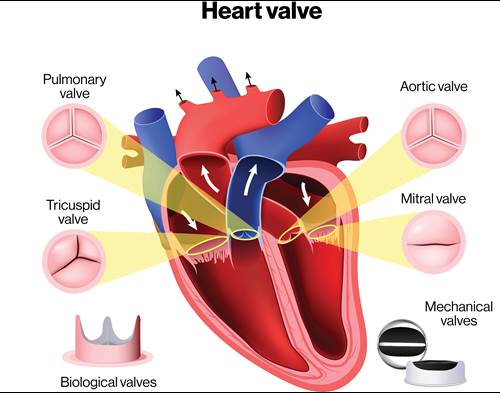In heart valve disease, the valves in the heart that regulate blood flow become damaged or malfunctioning. The heart has four valves that control the flow of blood through the chambers of the heart and into the arteries. These valves open and close with each heartbeat, allowing blood to flow in the correct direction. When a valve is damaged or not working correctly, it can cause the blood to flow back or not flow through the heart effectively.
Types of Heart valve disease
There are four main types of heart valve disease. These are classified based on the affected valve and the nature of the valve malfunction. These types are:
- Aortic stenosis: This occurs when the aortic valve becomes narrowed, which restricts the blood flow from heart to the body. Aortic stenosis is most commonly caused by age-related calcification or scarring of the valve.
- Mitral regurgitation: This occurs when the mitral valve does not close properly, causing blood to flow back into the left atrium of the heart. Mitral regurgitation can be caused by a number of factors, including damage to the valve from infection, congenital defects, or injury.
- Mitral stenosis: This occurs when the mitral valve becomes narrowed, which restricts blood flow from the left atrium to the left ventricle. Mitral stenosis is most commonly caused by rheumatic fever, which can lead to scarring and calcification of the valve.
- Aortic regurgitation: This occurs when the aortic valve does not close properly, causing blood to flow back into the left ventricle of the heart. Aortic regurgitation can be caused by a number of factors, including damage to the valve from infection, congenital defects, or injury.
Other less common types of heart valve disease include tricuspid valve disease and pulmonary valve disease. Tricuspid valve disease occurs when the tricuspid valve, which regulates blood flow between the right atrium and right ventricle, becomes damaged or malfunctions. Pulmonary valve disease occurs when the pulmonary valve, which regulates blood flow from the heart to the lungs, becomes damaged or malfunctions.
Causes
The causes of heart valve disease can vary depending on the type of valve affected, but some common causes include:
- Age-related wear and tear: Over time, the valves in the heart can become damaged or weakened. It can lead to heart valve disease.
- Congenital heart defects: Some people are born with abnormal heart valves that do not function properly.
- Rheumatic fever: This is a rare complication of untreated strep throat that can cause inflammation and scarring of the heart valves.
- Infection: Bacterial or viral infections can damage heart valves and cause them to malfunction.
- Atherosclerosis: Buildup of fatty deposits in the arteries can cause damage to the heart valves over time.
- Radiation therapy: Radiation therapy to the chest for cancer treatment can damage the heart valves.
- Trauma or injury: Trauma to the chest or heart can cause damage to the heart valves.
- Connective tissue disorders: Certain genetic disorders, such as Marfan syndrome and Ehlers-Danlos syndrome, can affect the development and function of heart valves.
It’s important to note that in some cases, the cause of heart valve disease may be unknown.
Symptoms of Heart valve disease
The symptoms can vary depending on the severity of the condition and which valve is affected. Some common symptoms include:
- Shortness of breath, especially during physical activity or when lying down
- Fatigue and weakness
- Chest pain or discomfort
- Palpitations or irregular heartbeat
- Swelling in the legs, ankles, or feet
- Dizziness or fainting
- Rapid weight gain
- Difficulty exercising or performing physical activities
- Coughing or wheezing, especially at night or when lying down
It’s important to note that some people with heart valve disease may not experience any symptoms, particularly in the early stages of the disease. However, if left untreated, heart valve disease can lead to serious complications, such as heart failure, stroke, or sudden cardiac death.
Diagnosis
Diagnosis of heart valve disease usually begins with a physical exam and medical history review by a doctor. The doctor will listen to your heart with a stethoscope to check for any abnormal heart sounds, such as a murmur, which may indicate valve disease. If valve disease is suspected, the doctor may order additional tests, such as:
- Echocardiogram: This is a non-invasive test that uses sound waves to create an image of the heart and its valves. An echocardiogram can show the size and shape of the valves, as well as any abnormalities in valve function.
- Electrocardiogram (ECG or EKG): This test measures the electrical activity of the heart. It can help detect irregularities in heart rhythm that may be associated with valve disease.
- Chest X-ray: A chest X-ray can show the size and shape of the heart, as well as any abnormalities in the lungs or surrounding structures that may be related to valve disease.
- Cardiac catheterization: This is an invasive test in which a thin tube is inserted into a blood vessel in the groin or arm and guided to the heart. This test can measure the pressure and oxygen levels in the heart and determine the severity of valve disease.
- CT or MRI scans: These tests can provide detailed images of the heart and its valves. It can help diagnose valve disease and determine the best treatment options.
Based on the results tests, the doctor can determine the type of heart valve disease and develop a treatment plan.
Treatment
The treatment for heart valve disease depends on the severity of the condition and the affected valve. In some cases, no treatment may be needed if the valve disease is mild and not causing any symptoms. However, if the valve disease is moderate to severe or causing symptoms, treatment options may include:
- Medications: Certain medications can help manage symptoms of heart valve disease, such as high blood pressure, fluid retention, and irregular heart rhythms.
- Valve repair or replacement: In some cases, surgery may be compulsory to repair or replace a damaged heart valve. This can be done through traditional open-heart surgery or minimally invasive procedures, such as transcatheter aortic valve replacement (TAVR) or mitral valve repair.
- Balloon valvuloplasty: This is a minimally invasive procedure in which a balloon-tipped catheter is used to widen a narrowed heart valve.
- Watchful waiting: In some cases, the best course of action may be to monitor the valve disease and treat symptoms as they arise.
The type of treatment recommended will depend on several factors. It includes the severity of the valve disease, the age and overall health of the patient, and the patient’s preferences and goals for treatment. It’s important to work closely with a doctor to determine the best treatment plan for individual needs.
Lifestyle For Patients
In addition to medical treatment, certain lifestyle changes can help manage symptoms. They also improve overall heart health for people with heart valve disease. Some lifestyle modifications that may be recommended include:
- Regular exercise: Exercise can help improve heart function and reduce symptoms of heart valve disease. It’s important to talk to a doctor before starting an exercise program.
- A heart-healthy diet: Eating a diet rich in fruits, vegetables, whole grains, lean protein, and healthy fats can help reduce the risk of heart disease and improve heart health.
- Quitting smoking: Smoking can damage the heart and blood vessels, making heart valve disease worse. Quitting smoking is one of the most important things a person can do to improve heart health.
- Managing stress: Stress can contribute to high blood pressure and other heart problems. Finding healthy ways to manage stress, such as through exercise, relaxation techniques, or therapy, can help improve heart health.
- Monitoring symptoms: Keeping track of symptoms and reporting any changes to a doctor can help prevent complications of heart valve disease.
It’s important to work closely with a doctor to develop a comprehensive treatment plan that includes medical treatment, lifestyle modifications, and regular monitoring. With the right care and management, many people with heart valve disease can lead healthy, active lives.
Related



